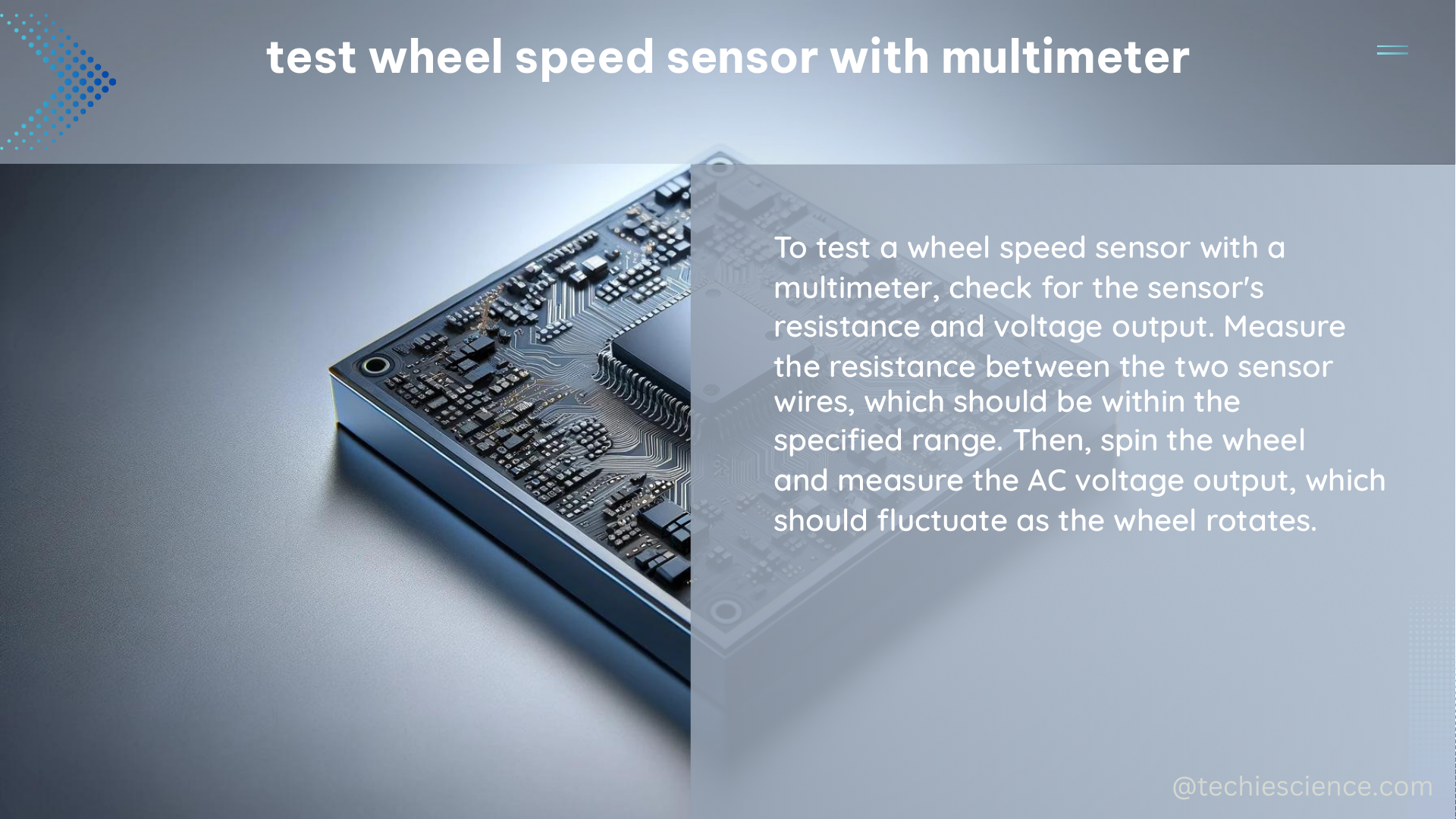Wheel speed sensors are critical components in modern vehicles, playing a crucial role in the operation of Anti-lock Braking Systems (ABS) and Electronic Stability Control (ESC) systems. Accurately testing these sensors using a multimeter is essential for diagnosing and troubleshooting potential issues. This comprehensive guide will provide you with the technical details and step-by-step instructions to effectively test a wheel speed sensor with a multimeter.
Understanding Wheel Speed Sensors
Wheel speed sensors are electromechanical devices that measure the rotational speed of a vehicle’s wheels. They typically consist of a magnetic pickup and a toothed wheel or reluctor ring, which generates a signal as the wheel rotates. This signal is then processed by the vehicle’s electronic control unit (ECU) to monitor wheel speed and provide data for various safety and performance systems.
There are two main types of wheel speed sensors:
- Active Sensors: These sensors require a power supply, typically in the range of 5 to 12 volts, and generate a digital signal that varies in frequency proportional to the wheel speed.
- Passive Sensors: These sensors do not require a power supply and generate an analog signal, typically a sine wave, with a frequency proportional to the wheel speed.
Preparing for Wheel Speed Sensor Testing

Before testing a wheel speed sensor with a multimeter, ensure that you have the following:
- Multimeter: A digital multimeter with the capability to measure resistance (Ohms), voltage, and continuity.
- Vehicle Service Manual: Refer to the manufacturer’s service manual for specific testing procedures and specifications for the wheel speed sensor in your vehicle.
- Safety Equipment: Wear appropriate personal protective equipment (PPE), such as safety glasses and gloves, to protect yourself during the testing process.
Step-by-Step Guide to Testing Wheel Speed Sensor with Multimeter
- Locate the Wheel Speed Sensor: Identify the location of the wheel speed sensor on your vehicle, which is typically mounted near the wheel hub or brake rotor.
- Disconnect the Sensor: Carefully disconnect the electrical connector from the wheel speed sensor, ensuring that you do not damage the wiring or the sensor itself.
- Set the Multimeter: Set your multimeter to the Ohms or resistance setting.
- Measure Resistance: Touch the multimeter probes to the terminals of the wheel speed sensor. The resistance reading should typically fall within the range of 500 to 1,000 ohms for most sensors.
| Sensor Type | Resistance Range |
|---|---|
| Active Sensor | 500 to 1,000 ohms |
| Passive Sensor | 500 to 1,000 ohms |
- Check for Continuity: Perform a continuity test by touching the multimeter probes to the sensor terminals. The multimeter should indicate continuity (a low resistance reading) when the probes are connected.
- Measure Voltage (for Active Sensors): If the sensor is an active type, set the multimeter to the voltage setting and measure the voltage at the sensor terminals. The voltage should typically be in the range of 5 to 12 volts.
- Interpret the Results: Compare the measured values with the specifications provided in the vehicle’s service manual. If the resistance or voltage readings are significantly outside the expected range, or if there is no continuity, the wheel speed sensor may be faulty and require replacement.
| Measurement | Acceptable Range |
|---|---|
| Resistance | 500 to 1,000 ohms |
| Continuity | Continuity (low resistance) |
| Voltage (Active Sensors) | 5 to 12 volts |
- Reassemble and Test: If the sensor passes the tests, reconnect the electrical connector and perform a functional test by driving the vehicle and observing the ABS or ESC system operation.
Troubleshooting Tips
- If the resistance or voltage readings are outside the expected range, check for any damage to the sensor, wiring, or connectors.
- Ensure that the multimeter is properly calibrated and functioning correctly before testing the wheel speed sensor.
- Consult the vehicle’s service manual for any specific testing procedures or diagnostic trouble codes related to the wheel speed sensor.
- If the sensor is still suspected to be faulty, consider replacing it and retesting the system.
Conclusion
Testing a wheel speed sensor with a multimeter is a crucial step in diagnosing and troubleshooting issues related to ABS, ESC, and other safety-critical systems in modern vehicles. By following the detailed steps and technical specifications outlined in this guide, you can effectively assess the condition of the wheel speed sensor and take appropriate action to ensure the proper functioning of your vehicle’s safety systems.
References
- Curriculum for Second Semester of Three-Year Diploma Courses in Polytechnics of UT of J&K: https://jksbotelive.com/2nd_Semester_Curriculum.pdf
-
- Dresdner Sensor-Symposium – AMA Science: https://www.ama-science.org/assets/Dresdner-Sensor-Symposium/16.-Dresdner-DSS-2022.pdf
- Measurement Science for Engineers: http://ndl.ethernet.edu.et/bitstream/123456789/36390/1/10.pdf
- Brake Discs and Wheel Speed Sensors in ABS Systems: https://www.hella-pagid.com/hellapagid/assets/media/Brake_Disc_ABS_PAGID_EN.pdf
- Check and Change ABS and Wheel Speed Sensors – HELLA: https://www.hella.com/techworld/us/Technical/Sensors-and-actuators/Check-change-ABS-sensor-4074/

The lambdageeks.com Core SME Team is a group of experienced subject matter experts from diverse scientific and technical fields including Physics, Chemistry, Technology,Electronics & Electrical Engineering, Automotive, Mechanical Engineering. Our team collaborates to create high-quality, well-researched articles on a wide range of science and technology topics for the lambdageeks.com website.
All Our Senior SME are having more than 7 Years of experience in the respective fields . They are either Working Industry Professionals or assocaited With different Universities. Refer Our Authors Page to get to know About our Core SMEs.